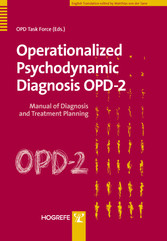Suchen und Finden
Mehr zum Inhalt

Operationalized Psychodynamic Diagnosis OPD-2 - Manual of Diagnosis and Treatment Planning
2 Experiences and Empirical Findings with OPD-1 (p. 19-20)
OPD serves not only state- but also process-diagnostic purposes. OPD, with its diagnostic categories and their operationalizations, is a considerable enrichment on the diagnostic horizon, precisely because it contributes to making psychodynamic constructs measurable which are relevant for therapy and change. It thus can be put to use in the planning and evaluation of therapy as well. In clinical practice, a thorough assessment using OPD can provide helpful hints for decisions and actions within the framework of treatment planning. The rating results from Axis I, for example, reflect relevant aspects of how a patient experiences illness, of his concepts of illness, and his motivation for change. On this basis the clinician is able to decide whether, at that point in time, the patient would benefit from a specific psychotherapeutic measure or whether more basic interventions are indicated to stabilize the patient first, perhaps gradually leading him towards psychotherapy. The OPD rating results from the other axes can reveal the patient’s core problem areas, which may assist with the formulation of treatment aims, as well as with the development of therapeutic interventions. Such core problem areas can be dysfunctional relationship patterns (Axis II), life-determining conflicts (Axis III), or “critical” structural characteristics (Axis IV) which describe particular vulnerabilities or limitations of the patient. These problem areas, which are laid down in the categories of the OPD, can be the foci that guide psychotherapeutic treatment. Moreover, the assessment of the patient’s structural level is per se an important piece of information about whether a more structure-oriented psychotherapeutic procedure is indicated, or rather an interpretative- disclosing intervention, which focuses on the dysfunctional handling of unconscious conflicts (Rudolf, 2004b).
An OPD-based model for the determination of therapy foci and therapy aims was developed during the course of a long-term analytical therapy practice study, or, in its German original, “Praxisstudie Analytische Langzeittherapie” (Grande et al., 2004b; Leising et al., 2003; Rudolf et al., 2001a; Rudolf et al., 2002a). It has proved its worth in in-patient and out-patient settings as clinically practicable and usable for the scientific evaluation of psychodynamically-oriented therapies. This model uses the so-called Heidelberg Structural Change Scale (HSCS) as an instrument to measure change by tracking the progress in the patient’s ability to deal with problem areas that are to be restructured through therapy (Grande, 2005; Grande et al., 2001; Grande et al., 2003; Rudolf et al., 2000; cf. Chapter 8 of this book). In addition, the formulation of a focus in terms of relationship dynamics has been helpful in in-patient treatment in order to promote a patientcentered attitude within the team (Stasch, 2003; Stasch & Cierpka, 2006).
2.1 Quality Criteria of OPD-1
With the publication of the OPD manual (Arbeitskreis OPD, 1996) a phase of intensive research began. The first reliability studies were quite satisfactory and had already been incorporated into the first OPD manual (Freyberger et al., 1996a). Consequent to this, interrater reliabilities were collected for the Axes II to IV on the basis of videotaped initial clinical interviews in the area of in-patient treatment. Experience gained from teaching the system and from its application has shown that not only the training, but also the quality of the material examined, and the clinical training and professional experience of the raters, play an important role in the quality of the ratings.
A study by the OPD-1 working group (cf. Cierpka et al., 2001) recruited 269 patients from 6 clinics for psychosomatic medicine to test the reliabilities of Axes I to IV. As the rating conditions in the various clinics differed along important parameters, the experimenters were able simultaneously to look at what conditions improved or worsened the reliability of the assessments. The measure they used was the weighted kappa (Cohen, 1968), which in contrast to the intraclass correlation coefficient (ICC) makes no parametric demands and was thus better suited to the data than the latter. To determine the weights, the intervals on the rating scales, which each contained four subscales, were assumed to be equidistant for the Axes I, III, and IV; this leads to a kappa that can be interpreted similarly to a Pearson correlation coefficient (Fleiss/Cohen, 1973). On Axis II “interpersonal relations”, the experimenters also calculated the weighted kappa. The procedure in this case corresponded to the standard procedure used in the Structural Analysis of Social Behavior (SASB, Benjamin, 1974); in this, deviation weights in kappa are adjusted to the logic of the circumplex model of interpersonal behavior with a method described by Grawe-Gerber and Benjamin (1989).
Alle Preise verstehen sich inklusive der gesetzlichen MwSt.










